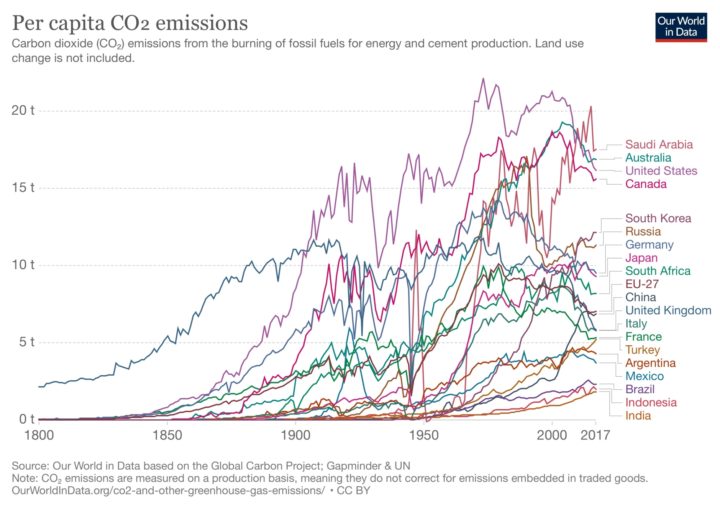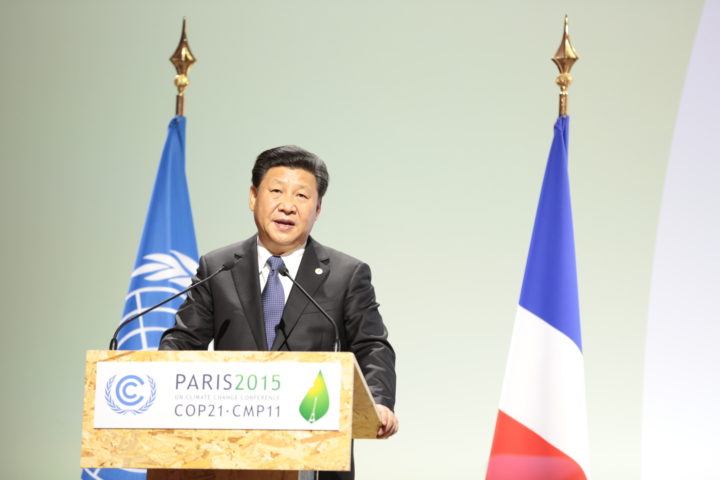Why emissions matter to China - and China's emissions matter to the world
China helped lead at COP21 to land the Paris Agreement. Although lower per-capita and historically, their annual emissions are highest globally. Ahead of COP26, it is in their interests to lead again.

By Gareth Redmond-King
@gredmond76Share
Last updated:
Sign up to receive one regular email, packed with insight and analysis in the run up to -and during - the COP26 in Glasgow in October.
Getting the world to net-zero by mid-century, to keep average global temperature rises to 1.5°C, requires action from every party to the Paris Agreement to cut emissions rapidly in this decade.
That said, the accord acknowledges ‘common but differentiated’ efforts – that mid-century for developed nations should be 2050, with developing countries a decade or so later. It recognises, in other words, that some parties have been emitting for far longer than others.
But, as time passes and the window for cutting emissions in line with 1.5° closes inexorably, it becomes ever more pressing that parties are living up to commitments made in the Paris Agreement, and are acting in line with the science agreed via the Intergovernmental Panel on Climate Change (IPCC). That means submitting enhanced nationally determined contributions (NDCs) – pledges for emissions cuts – before COP26.
As of late July, new NDCs have been submitted by fewer than half of the parties to the Paris Agreement, covering only just over half of global emissions. More than a third of those new NDCs are from less-developed countries and small-island states – nations most threatened by climate but who contribute the least in terms of emissions. All commit to enhanced ambition.
Of parties yet to submit, some stand out a little more than others, given the scale of their emissions.
G20 emissions gap
As we explored recently in this briefing, G20 nations are crucial to closing the emissions gap ahead of COP26. They are responsible for nearly 80% of global emissions, yet only half of those are yet covered by ambitious pledges to cut them in line with Paris.
One G20 nation, though, is now responsible for a quarter of annual global emissions: China.
Historic and per capita emissions
China has not been emitting for as long as the UK, the US, or other wealthy developed nations. Nor are its per capita emissions in the top half of the G20 nations’ list.
Added to this, wealthy, developed nations effectively export emissions to nations like China, through consumption of manufactured goods.
All this means that, even at just 1% of global emissions, the UK cannot delay climate action on the basis that China has a much bigger impact. As of 2018, the UK was the fifth biggest historic emitter, behind Germany, the former Soviet Union/Russia, China, and the US.
The animation and graph below show cumulative and per capita emissions of different countries since the industrial revolution.

Inadequate emissions pledge
But, in 2021, with just three months to the UN climate summit in Glasgow, COP26, closing the emissions gap to keep 1.5° within reach requires that China acts too.
China's existing emissions pledge under the Paris Agreement (NDC) is rated by Climate Action Tracker as ‘highly insufficient’; it effectively allows their emissions to double from 2005 to 2030, linked to GDP growth.
Despite making a Paris-aligned commitment that they would achieve net-zero by 2060, they cannot achieve this, or their related commitment to peak CO2 emissions by 2030 without short-term action to cut emissions this decade.
If China does not enhance its emissions pledge
To be on track for Paris, the world already faces the very challenging task of halving emissions by 2030. If China does not enhance its NDC as part of that effort, then the sheer scale of their emissions – 12 gigatons a year – would mean that the rest of the world would then need to slash their emissions by an eye-watering two-thirds to keep 1.5° within reach.
In that scenario, China would be responsible for nearly half of global emissions in 2030.
How can China reduce emissions?
Coal
One of the biggest issues for China is its reliance on coal – amounting to around 50% of global coal power capacity; a level which should be nearly zero by 2040, for a net-zero pathway.
At President Biden’s climate leaders’ summit in April, China’s President, Xi Jinping, did commit to begin to scale down that reliance on coal from 2025. But China still has 250GW of new coal power under development, and much of its fleet is relatively young, and with a lifespan beyond 2050.
Not just coal at home; China has invested in coal overseas as well. Although renewables make up the bulk of China’s ‘belt and road initiative’ (BRI) spending, in 2020 this came alongside some $20bn investment in coal (27% of the total, up from 15% in 2018).
Speaking at the 2021 UN General Assembly, though, Xi Jinping signalled a significant change to this, committing that China will "step up support for other developing countries in developing green and low carbon energy, and will not build new coal-fired power projects abroad".
Economic interests
Globally, and for individual nations, the costs of not acting to cut emissions are higher than those of taking climate action, and the economic benefits of climate action are huge.
A 2018 study calculated that China could see an annual hit to their GDP of -1.7% in a 2°C warming scenario, and -4.6% in a 4°C of warming. Even if the world cuts in line with current Paris emissions pledges, China could face 100m people endangered by rising sea levels by 2050, hundreds of millions at risk of deadly heatwaves in the country by 2070, and severe harm to globally important food supplies. In just the last week or so, we have seen the devastating impacts of extreme flooding in China, as well as in many other nations around the world.
By contrast, action in line with 1.5° to cut reliance on coal and transition to zero-emission vehicles could prevent nearly 2m premature deaths from exposure to air pollution. And China’s GDP could grow by 2-3% as a result of investment in delivering net-zero. China has also already taken major steps towards transition to clean technology, being the world’s largest market for clean energy, one of the biggest global investors in renewables, and having leading edge policies to drive replacement of fossil-fuelled vehicles with electric ones.

Past leadership
China has, in many ways, led on climate action, recognising the economic value of being a world leader in solar power manufacturing, and of investing in renewables overseas through its belt and road initiative. This is enhanced by Xi Jinping's 2021 UN General Assembly commitment to end funding for new coal-fired projects overseas. China has also acknowledged the need to be net-zero by mid-century, and is clearly exploring routes to that.
Alongside the US under Barack Obama, China was immensely influential in leading the world to securing the Paris Agreement at COP21 in 2015. It could clearly do so again now, at continued economic benefit, whilst reducing exposure to hugely costly future harm.
As of 23rd July, there were just 100 days left to the start of COP26 – a summit whose aim will be to keep the Paris Agreement’s promise of 1.5° within reach. Enhanced commitments from China in the coming weeks could bring other G20 nations along in time for Glasgow to keep 1.5 alive.
This briefing was updated on 22nd September 2021 to reflect Xi Jinping's speech to the 2021 UN General Assembly.

Sign up to receive one regular email, packed with insight and analysis in the run up to -and during - the COP26 in Glasgow in October.
Share